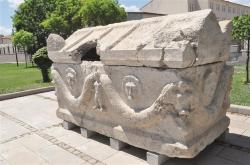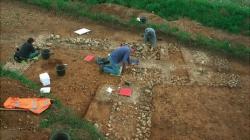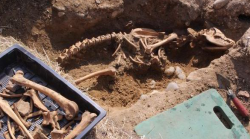INSTITUT SUPERIEUR D'ANTHROPOLOGIE
INSTITUTE OF ANTHROPOLOGY
ONLINE COURSES / COURS A DISTANCE
SUMMER TERM : JULY 2014
REGISTER NOW
TURQUIE –  Turgutlu- An illegal excavation in the northern Anatolian province of Çorum’s Sungurlu district has unearthed a 1,900-year-old tomb. The tomb has been removed from the excavation area by archaeologists and moved into the Çorum Museum for display. The tumulus in Turgutlu village, where the tomb was found, was illegally excavated in 2012 before the region was registered as a first-degree archaeological area, said Gov. Sabri Başköy, adding that some public officials were involved in the illegal excavations. A new illegal excavation was also carried out on the tumulus in March this year, the governor said, adding that they were informed that the tomb was unearthed during this excavation. “The tomb adds a value to Çorum’s underground richness. It is the largest tomb found in the province. We hope that it will contribute to the promotion of Çorum,” he said. Examinations showed that the tomb dated from 96-98 A.D., Başköy said, adding that those involved in the illegal excavations were being investigated.Başköy said they were certain the tomb was 1,900 years old. “We believe that there was a female body inside the tomb. It was sent to Ankara for tests. The gender and age of the body will be identified,” he said. Speaking about the features of the tomb, Çorum Museum Director Önder İpek said: “The tomb cover is 240 centimeters. It is 120 centimeters in width and 58 centimeter in height. The two long sides of the tomb cover were broken by smugglers who wanted to enter it. One of the acroteria was also broken. Some pieces of this acroterion were found by experts and attached to their place by the conservator of the museum. Eros, the god of love in Greek mythology, is embroidered on the surface of the tomb. The head of Eros received damage because of smugglers.” In addition to the pieces of human skeleton, a silver coin, a gold earring and a ring were also found inside the tomb, İpek said.
Turgutlu- An illegal excavation in the northern Anatolian province of Çorum’s Sungurlu district has unearthed a 1,900-year-old tomb. The tomb has been removed from the excavation area by archaeologists and moved into the Çorum Museum for display. The tumulus in Turgutlu village, where the tomb was found, was illegally excavated in 2012 before the region was registered as a first-degree archaeological area, said Gov. Sabri Başköy, adding that some public officials were involved in the illegal excavations. A new illegal excavation was also carried out on the tumulus in March this year, the governor said, adding that they were informed that the tomb was unearthed during this excavation. “The tomb adds a value to Çorum’s underground richness. It is the largest tomb found in the province. We hope that it will contribute to the promotion of Çorum,” he said. Examinations showed that the tomb dated from 96-98 A.D., Başköy said, adding that those involved in the illegal excavations were being investigated.Başköy said they were certain the tomb was 1,900 years old. “We believe that there was a female body inside the tomb. It was sent to Ankara for tests. The gender and age of the body will be identified,” he said. Speaking about the features of the tomb, Çorum Museum Director Önder İpek said: “The tomb cover is 240 centimeters. It is 120 centimeters in width and 58 centimeter in height. The two long sides of the tomb cover were broken by smugglers who wanted to enter it. One of the acroteria was also broken. Some pieces of this acroterion were found by experts and attached to their place by the conservator of the museum. Eros, the god of love in Greek mythology, is embroidered on the surface of the tomb. The head of Eros received damage because of smugglers.” In addition to the pieces of human skeleton, a silver coin, a gold earring and a ring were also found inside the tomb, İpek said.
http://www.hurriyetdailynews.com/female-body-discovered-in-centuries-old-tomb-.aspx?PageID=238&NID=66517&NewsCatID=375
ROYAUME UNI –  Fetcham - Rare archaeological findings dating back 10,000 years were unearthed during work to replace water mains in Surrey.A Stone Age hunting camp and a Roman villa were among finds made during the work in Cobham Road, Fetcham, carried out by Sutton and East Surrey Water. The camp was the oldest find along items from the Bronze and Iron Ages, according to a report by researchers.The camps is believed to have been used by hunter-gatherers to knap - or shape - flint to make or repair hunting equipment.The site is very close to the River Mole and the report said it would have provided an area with access to water, waterfowl, game and shelter. The remains of a Roman building, consisting of flint wall foundations, were also identified, with evidence of a bathhouse complex and other remains such as pottery.
Fetcham - Rare archaeological findings dating back 10,000 years were unearthed during work to replace water mains in Surrey.A Stone Age hunting camp and a Roman villa were among finds made during the work in Cobham Road, Fetcham, carried out by Sutton and East Surrey Water. The camp was the oldest find along items from the Bronze and Iron Ages, according to a report by researchers.The camps is believed to have been used by hunter-gatherers to knap - or shape - flint to make or repair hunting equipment.The site is very close to the River Mole and the report said it would have provided an area with access to water, waterfowl, game and shelter. The remains of a Roman building, consisting of flint wall foundations, were also identified, with evidence of a bathhouse complex and other remains such as pottery.
http://www.bbc.com/news/uk-england-kent-27409374
ROYAUME UNI – 
 Leiston Abbey -The skeleton of a huge hound believed to have terrorised villagers four centuries ago has been found in a ruined abbey.The beast weighed up to 200lbs and stood 7ft tall on its hind legs. Archaeologists unearthed the bones at Leiston Abbey in Suffolk near where, according to legend, a hell hound called Black Shuck with flaming eyes and shaggy black fur appeared during a storm on August 4, 1577. The legend said that thunder caused the doors of Holy Trinity Church, Blythburgh, to burst open and the snarling dog crashed in and ran through the congregation, killing a man and a boy, before it fled when the steeple collapsed. Marks still visible on the church door are said to be from its claws. Brendon Wilkins, projects director of archaeological group Dig Ventures, said: “Most of these legends about dogs may have some roots in reality'.
Leiston Abbey -The skeleton of a huge hound believed to have terrorised villagers four centuries ago has been found in a ruined abbey.The beast weighed up to 200lbs and stood 7ft tall on its hind legs. Archaeologists unearthed the bones at Leiston Abbey in Suffolk near where, according to legend, a hell hound called Black Shuck with flaming eyes and shaggy black fur appeared during a storm on August 4, 1577. The legend said that thunder caused the doors of Holy Trinity Church, Blythburgh, to burst open and the snarling dog crashed in and ran through the congregation, killing a man and a boy, before it fled when the steeple collapsed. Marks still visible on the church door are said to be from its claws. Brendon Wilkins, projects director of archaeological group Dig Ventures, said: “Most of these legends about dogs may have some roots in reality'.
”http://www.express.co.uk/news/weird/476277/Hell-Hound-found-Bones-of-an-ancient-huge-hound-found-at-ruined-abbey?utm_source=feedburner&utm_medium=feed&utm_campaign=Feed%3A+daily-express-weird-news+%28Daily+Express+%3A%3A+Weird+News+Feed%29
FINLANDE –  Kvarnbo - According to archaeologists aerial infrared images suggest the existence of a late Iron Age settlement, possibly the largest such find ever in the Åland Islands or all of mainland Finland. The aerial imaging highlighted a depression 40 metres deep and 12 metres wide which might have been the site of a massive hall used to host gatherings of ancient Vikings. No other similar find of this size has ever been discovered in the Ålands of on the Finnish mainland. The imaging project followed observations of depressions which resembled the outlines of late Iron Age structures from other parts of Scandinavia. Once the images revealed the outline of the hall, cautious excavation turned up personal ornaments cast in silver and bronze, and which point to the site as an important location in the Viking world. Researchers working under the leadership of archaeologist Dr. Kristin Ilves found that the items had been forged in the shape a bird of prey as well human or animal heads. These findings they say, give weight to the theory that the site was visited by persons of elevated status. The jewelry has been dated back to between the 5th and 10th century.
Kvarnbo - According to archaeologists aerial infrared images suggest the existence of a late Iron Age settlement, possibly the largest such find ever in the Åland Islands or all of mainland Finland. The aerial imaging highlighted a depression 40 metres deep and 12 metres wide which might have been the site of a massive hall used to host gatherings of ancient Vikings. No other similar find of this size has ever been discovered in the Ålands of on the Finnish mainland. The imaging project followed observations of depressions which resembled the outlines of late Iron Age structures from other parts of Scandinavia. Once the images revealed the outline of the hall, cautious excavation turned up personal ornaments cast in silver and bronze, and which point to the site as an important location in the Viking world. Researchers working under the leadership of archaeologist Dr. Kristin Ilves found that the items had been forged in the shape a bird of prey as well human or animal heads. These findings they say, give weight to the theory that the site was visited by persons of elevated status. The jewelry has been dated back to between the 5th and 10th century.
http://yle.fi/uutiset/archaeologists_find_evidence_of_possible_viking_stronghold_in_alands/7242326